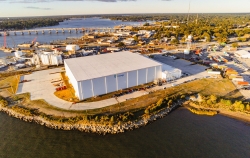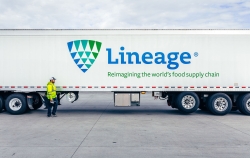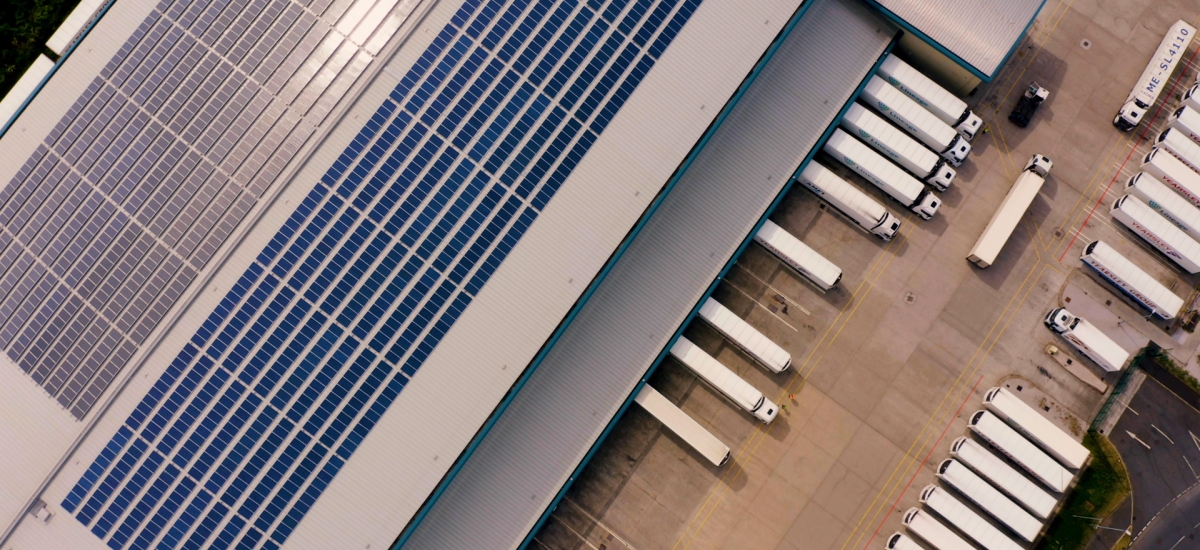A Million Little Things: Lineage’s Journey to Net-Zero
December 21, 2022
One year ago, Lineage took a big step towards helping to preserve our planet by signing The Climate Pledge – and the commitment that comes with it to achieve net-zero carbon emissions by 2040 is more important than ever before. With the effects of climate change being felt all around the world, it’s up to every one of us to do what we can to protect the planet we call home.
We believe it takes more than the big projects to really move the needle when it comes to achieving net-zero emissions. It’s the million little things that add up to big changes. Whether it’s investing in renewable energy sources like solar, retrofitting older buildings to be more energy efficient or taking steps towards more sustainable transportation solutions, Lineage is reimagining the sustainability standard in our industry. It’s no secret that it takes a lot of energy to keep the food we enjoy at a safe and enjoyable temperature – so as the most innovative player in the cold chain, we know it’s our responsibility to lead the industry into a more sustainable future.
Going Solar
One of the ways we’re working to achieve our goal of net-zero carbon emissions by 2040 is with our solar initiatives. Just behind hydropower and wind, solar energy is the third largest renewable electricity technology in the world. In 2021 alone, the world added 295 gigawatts of new renewable power capacity; a staggering feat in the face of lingering supply chain woes and a testament to the importance and necessity of this energy revolution.
Lineage hasn’t been sitting idly by either. Over the past year, installing and expanding our solar footprint has been a major part of our global sustainability strategy, and we’re already starting to see significant results. In the US, Lineage has more than 108 MW of on-site solar installations across our network. According to the 2022 Solar Means Business report from the Solar Energy Industries Association (SEIA), this makes us the 5th largest adopter of on-site solar in the US, just behind Target, Prologis, Walmart, and Amazon. We’ve also had more on-site solar installations since 2020 than any other company on the list, with 87.2 MW installed and no signs of slowing down.
On average, our facilities with on-site solar installations can produce about 40% of their energy. Combine that capability with energy saving measures like installing LED lights in all our buildings and utilizing VFDs (variable frequency drives) in our refrigeration systems, and that percentage continues to rise. It’s amazing what can be done with what would’ve otherwise been unused space on the roofs of these facilities.
Growing Our Global Solar Footprint – One Step at a Time
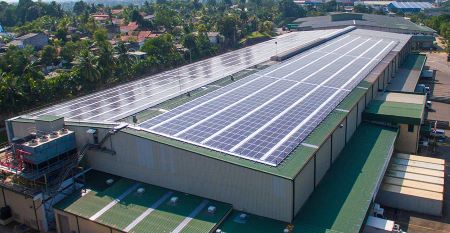 In Europe and Asia Pacific, our solar initiatives are just as ambitious. Overall, our European solar footprint has increased 46% year over year, from 15.7 MW to 34.3 MW. In the UK this year, we’ve expanded our solar footprint to nearly every one of our locations. Solar installations at our locations in Peterborough, Bellshill and Heywood amount to removing over 500 tons of CO2 emissions per year, or the equivalent of planting more than 21,000 trees.
In Europe and Asia Pacific, our solar initiatives are just as ambitious. Overall, our European solar footprint has increased 46% year over year, from 15.7 MW to 34.3 MW. In the UK this year, we’ve expanded our solar footprint to nearly every one of our locations. Solar installations at our locations in Peterborough, Bellshill and Heywood amount to removing over 500 tons of CO2 emissions per year, or the equivalent of planting more than 21,000 trees.
In the Netherlands, we’re also making big pushes in sustainability with huge solar installations at our state-of-the-art facilities in Rotterdam and Vlissingen. Our Cool Port I facility in the Port of Rotterdam houses over 11,000 solar panels on its roof, making it one of the leaders in the area. The brand new, fully automated Cool Port II facility will get its own solar arrays in mid-2023.
At the Vlissingen facility, Lineage is installing over 27,000 solar panels, which can produce around 40% of the energy consumed at the location. This huge array will generate up to 14.6 MW of energy for the site which equates to the annual energy consumption of 4,500 households. This ambitious installation is Lineage’s largest European investment in solar power and the fourth largest privately-owned solar installation in the Netherlands.
Lineage’s solar strategy in the Asia Pacific region is gaining steam as well. With robust solar arrays already in place at several facilities in Vietnam and Sri Lanka and 3 more to come in Vietnam in the next year, Lineage is continuing to build up our solar foundation on a global scale. Throughout 2023 and 2024, across Australia and New Zealand, Lineage plans to install solar panels to 11 of its locations. These solar arrays will produce about 23.6 MW of energy, supplying about 30% of the total power consumed on site.
Investing in the Future with Mainspring Linear Generators
Lineage’s investment into solar power production is a major step towards achieving net-zero emissions by 2040, but it’s not the only thing we’re doing when it comes to producing our own power. One of the possible problems that come with the world’s transition towards a zero-emission future is a more volatile power grid. That’s where Mainspring Energy comes in.
Mainspring Energy developed a linear generator that can be used on-site at any of our facilities. These generators create electricity by using a low-temperature reaction of fuel and air. Unlike a combustion-based generator, linear generators work by directly converting motion into electricity by using a low temperature reaction, below the levels at which NOx emissions form. The goal of these units is for them to work in conjunction with solar arrays to ensure reliability and optimal use of our renewable energy at all times. In the end, this increases energy resiliency at these sites by reducing our dependence on the grid. If the power is shut down in that area, our Mainspring generators will be able to kick on and prevent any loss of power, protecting our customers’ products and the world’s food supply.
One example of these Mainspring generators in action is at Lineage’s Colton, CA location, where we’re producing 100% of the energy used on site. This was the first facility in the world with two linear generators and the first of its kind to integrate a linear generator with solar panels.
The best part about these generators is that they can be powered with a variety of different low-emission and no-emission fuel sources. Hydrogen, ammonia, natural gas and even biogas fuel sources are viable options with these generators, setting us up for a more resilient future. As we begin to implement these fuel-flexible generators in more locations over the next few years to complement our solar arrays, our energy management team is hard at work finding the perfect zero-emission fuel source.
Energy Efficiency is in Our DNA
Producing clean energy is a big part of our sustainability story, but it doesn’t mean much if we don't find ways to track and conserve it as well. Energy efficiency is part of the Lineage DNA; it must be in an industry as energy intensive as supply chain logistics, and this is where the million little things really start to add up.
It all goes back to our purpose statement: to transform the food supply chain to eliminate waste and help feed the world. We absolutely must consider energy when we’re talking about waste. To us, finding ways to become more energy efficient is part of being good corporate citizens. To ensure we’re being as efficient as possible with the energy we’re using and producing; we need to focus on two key areas: infrastructure and refrigeration.
Efficiency Starts with Infrastructure
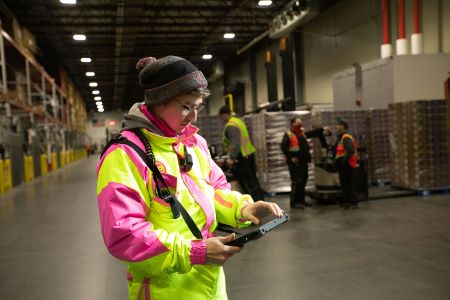 Unlike wine, buildings don’t typically get any better with age. In a cold storage facility, this is especially important to keep in mind. There’s a lot that goes into building and maintaining a cold storage facility. Every part is essential; from the evaporators, compressors and condensers, down to the seals on valves and doors throughout the building. Every little piece works together to create and maintain a safe and cold environment for the food we eat.
Unlike wine, buildings don’t typically get any better with age. In a cold storage facility, this is especially important to keep in mind. There’s a lot that goes into building and maintaining a cold storage facility. Every part is essential; from the evaporators, compressors and condensers, down to the seals on valves and doors throughout the building. Every little piece works together to create and maintain a safe and cold environment for the food we eat.
One of the ways we ensure the energy we’re using and producing isn’t being wasted is through our waste walks. Waste walks act as another set of eyes to complement the other assessment tools and systems already in place at these facilities. However, these walks are done with a singular focus on energy efficiency.
During these walks, our crews are on the lookout for all possible factors that may lead to wasted energy. It involves looking at seals around doors, where even a 3-inch gap could lead to significant energy wastage and a larger carbon footprint; checking if evaporators are iced over, ensuring they are regularly defrosted to maintain optimal performance; taking a look at the condensers to make sure they’re working properly; and even making sure all of our lights are upgraded to highly efficient LEDs. All the little things add up and if anything isn’t working the way it should, that results in higher energy usage or waste.
These waste walks aren’t just beneficial to older buildings, they’ve generated great results at some of our newest facilities as well. At our Portsmouth, VA location, a recent waste walk was able to find optimizations that resulted in reducing energy waste by a whopping 20%.
Energy training for the maintenance teams throughout our network has helped instill a philosophy of efficiency and an eye for waste. This means our team can identify gaps and flaws throughout our buildings, then develop and implement the solutions necessary to protect the energy we’re using in these buildings. It’s all part of ensuring energy efficiency makes up a part of the Lineage DNA.
At the end of the day, waste walks act as a health check on our buildings. In our energy-intensive industry, it’s absolutely essential that we’re all operating with energy efficiency on our minds. These waste walks are performed on a regular basis at all our facilities in an effort to account for every watt being used. In this way, we’re eliminating waste by transforming the way we look at the food supply chain.
Refrigeration Optimizations are Key
While checking and optimizing the refrigeration settings is important, it’s also important to make sure we’re updating the refrigeration systems themselves. As we acquire more buildings, it is important to modernize them as many are over 30 years old. We're making operations as safe and efficient as possible by implementing best practices we've learned through decades of experience.
One of our most impactful energy efficiency initiatives is the deployment of cutting-edge refrigeration controls technology. For several years, our Data Science team has been collaborating with CrossnoKaye, a modern software controls company, to develop and deploy the ATLAS platform. Atlas is an intelligent cloud-based control system that uses advanced physics-based machine learning algorithms to optimize the operational efficiency of refrigeration systems, reduce costs and maximize throughput to make industrial cold storage facilities smarter, safer and more reliable than ever. It has already reduced energy usage by up to 48% at pilot sites, reducing our energy spend and greenhouse gas emissions. We aim to deploy ATLAS at over twenty facilities in the next year alone.
Another important way to ensure we’re being efficient with our energy consumption is through the digitization of our entire network. Thanks to our long-time partner Ndustrial, this is made possible by integrating our warehouse management systems, refrigeration control systems and energy systems into a real-time digital twin, processing over 100 million data points daily. Through their real-time industrial intelligence platform, Contxt, we’re able to analyze and manage all the electrical consumption data at any site using the Ndustrial Nsight software and smart meters. This gives Lineage a much more granular view of our global emissions and carbon intensity for more robust ESG reporting. This increased digitization gives us greater control over the energy we use and allows us to identify opportunities for optimizations ranging from energy intensive processes like blast freezing to energy markets participation. With over 300 facilities on the platform in North America and globally, we continue to deploy Ndustrial across our newly acquired facilities.
Waste walks also look for optimizations within the refrigeration systems. Within these facilities, different products need to be kept at different temperatures. This is to ensure the preservation and safety for consumers. During our waste walks, our crews make sure each and every room is kept at the precise temperatures required for each item. This is done in accordance with customer requirements as well as government regulations.
By ensuring our rooms are set at just the right temperature, we’re accounting for every watt we use. Even slight changes in the temperature can have a huge effect on energy usage, so keeping track of any changes and making the necessary optimizations allows us to conserve the energy we use. Making these tweaks to the refrigeration configurations can easily save between 10-15% on average.
The implementation of VFDs is another way we’ve been able to optimize our refrigeration systems. VFDs work with the condensers, evaporators and compressors in these systems to provide the precise amount of energy needed to operate these devices. This precision allows for us to cut as much as 35% of energy being used without VFDs.
Over the years, regulations around the types of refrigerants that can be used have changed drastically. We’re in the process now of identifying older refrigeration systems across our global network and upgrading them to ammonia-based and transcritical CO2 systems.
Transportation: A Roadmap for the Future
Transportation is the biggest contributor of greenhouse gasses in the US and one of the biggest contributors in the world, accounting for 27% of all greenhouse gas emissions in the US and 14% in the world. Transportation also happens to be a big part of what we do, which is why we’ve made it a priority in our sustainability strategy going forward.
Lineage is hard at work all over the world, finding creative ways to reduce carbon emissions every step of the journey. Whether it’s optimizing our routes to find the most fuel-efficient paths for our vehicles; maximizing our load fills to ensure we’re utilizing our fleet the best that we can; or upgrading our fleet to the most fuel-efficient vehicles possible, something we’re focusing on heavily in Europe, all these small steps add up to big differences in our overall carbon footprint. Even building out our rail offerings is helping us on our way to net-zero emissions. One railcar provides the capacity of up to four truckloads by weight and if 25% of the truck traffic moving at least 750 miles went by rail, annual greenhouse gas emissions would fall by as much as 13.1 million tons. Possibly the biggest area where you can see the futurization of the Lineage fleet is through our electrification efforts.
Electric Yard Goats
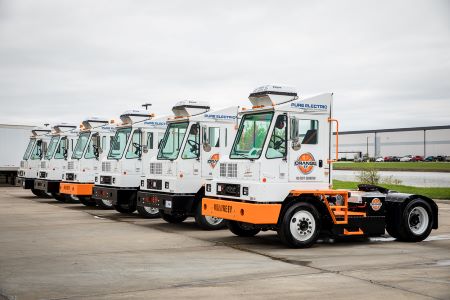 One of the biggest sources of carbon emissions on-site at our facilities are our yard goats. A yard goat, also know as a yard tractor or yard shifter, is a specialized vehicle we use on-site to switch truck trailers between dock doors and parking spots. As trucks come into our facilities, they drop off their trailers which are then moved to the appropriate dock doors by our yard tractors. Each of our sites have at least one yard goat to perform these duties. The problem with these vehicles is that they run on diesel fuel.
One of the biggest sources of carbon emissions on-site at our facilities are our yard goats. A yard goat, also know as a yard tractor or yard shifter, is a specialized vehicle we use on-site to switch truck trailers between dock doors and parking spots. As trucks come into our facilities, they drop off their trailers which are then moved to the appropriate dock doors by our yard tractors. Each of our sites have at least one yard goat to perform these duties. The problem with these vehicles is that they run on diesel fuel.
To achieve net-zero emissions by 2040, we know it’s time to rethink how we move trailers around our facilities. That’s where EV yard goats from Orange EV come in. Orange EV is a Missouri-based organization that builds, sells and services industrial electric vehicles for commercial organizations. Their EV yard goats are fully electric and release zero emissions, the perfect answer to our diesel problem.
These electric vehicles can perform all the same functions as diesel yard goats, but with zero emissions. Not only that, but the maintenance on these vehicles is much less than diesel yard tractors because they don’t use a combustion engine. These have already been rolled out to our Olathe, KS location and will be rolled out to facilities throughout California and Texas in 2023. In the future, we hope to expand these yard goats to all our facilities.
Electrifying Our Infrastructure
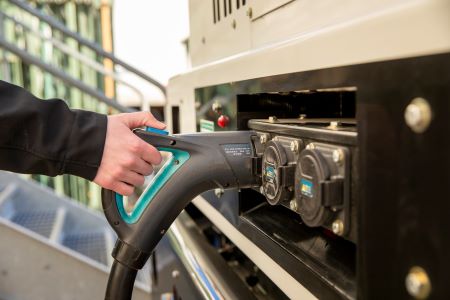 We believe that to help usher in a new era of electric vehicles, the charging infrastructure needs to be there. That’s why in the next year we’ll be making big investments at many of our facilities to install electric vehicle chargers. Not only will this be used for our own electric yard goats and EVs, but it’ll act as an incentive for our customers to start making the shift as well. Lineage is also installing yard plugs throughout these facilities in our efforts to move away from diesel powered generators for our TRUs. All of this is to mitigate our carbon emissions and build a more sustainable infrastructure for the future.
We believe that to help usher in a new era of electric vehicles, the charging infrastructure needs to be there. That’s why in the next year we’ll be making big investments at many of our facilities to install electric vehicle chargers. Not only will this be used for our own electric yard goats and EVs, but it’ll act as an incentive for our customers to start making the shift as well. Lineage is also installing yard plugs throughout these facilities in our efforts to move away from diesel powered generators for our TRUs. All of this is to mitigate our carbon emissions and build a more sustainable infrastructure for the future.
We have already rolled out an electrified infrastructure at our Big Bear, CA location with plans to expand to the rest of our California locations in the next year. The largest of these projects will be at our Mira Loma and San Leandro facilities.
The Future is Green
No doubt about it, the future of Lineage is green, with 2021 and 2022 serving as a baseline for our emissions and energy usage. In just one short year since signing The Climate Pledge, we made big strides in many key areas, including expanding our solar footprint, developing waste walks for all our facilities, investing in Mainspring linear generators at key locations, developing and leaning into refrigeration optimization software, and setting up an electrified future for the transportation arm of our business.
And we’re not slowing down. We have aggressive plans to expand our solar footprint to even more of our facilities around the world; including investing in solar for all possible locations within our global network to produce energy and reduce the amount we pull from the grid. For any of our locations where a solar array isn’t possible, we will be investing in strategically selected off-site solar arrays.
Identifying antiquated refrigeration systems within our network and modernizing them to ensure the highest energy efficiency possible is a major part of our strategy as well. Utilizing VFDs wherever possible, sealing up any gaps and investing in an automatic system to monitor and fine-tune our refrigeration systems 24/7 are just a few of the ways we’re future-proofing the cold chain. We’ll also continue to focus on the million little opportunities for optimization around our buildings – not only to improve energy efficiency across the board while cutting down on emissions, but also to prioritize the safety for our team members.
Further expanding the foundation and infrastructure for electric vehicles at our facilities will also help pave the way for more EVs to be used on-site, both by us and by our customers. Cutting down the emissions of these vehicles, whether it be by investing in our own electric trucks, implementing more electric yard goats or encouraging our customers to electrify their fleet, will play a major role in achieving net-zero carbon emissions by 2040.
With so many plans, priorities and initiatives, we’re working to identify meaningful milestones for our energy usage and carbon emissions on our way to net-zero emissions by 2040. By working with the data we’ve accrued over the past year, we’re able to see where we’re at right now and what steps need to be taken to achieve real progress.
In the end, it’s not just the major projects that push the needle forward, though they will play an important part. Rather, it’ll be the million little things we do along the way that will determine our sustainability success – and this is only the beginning.
